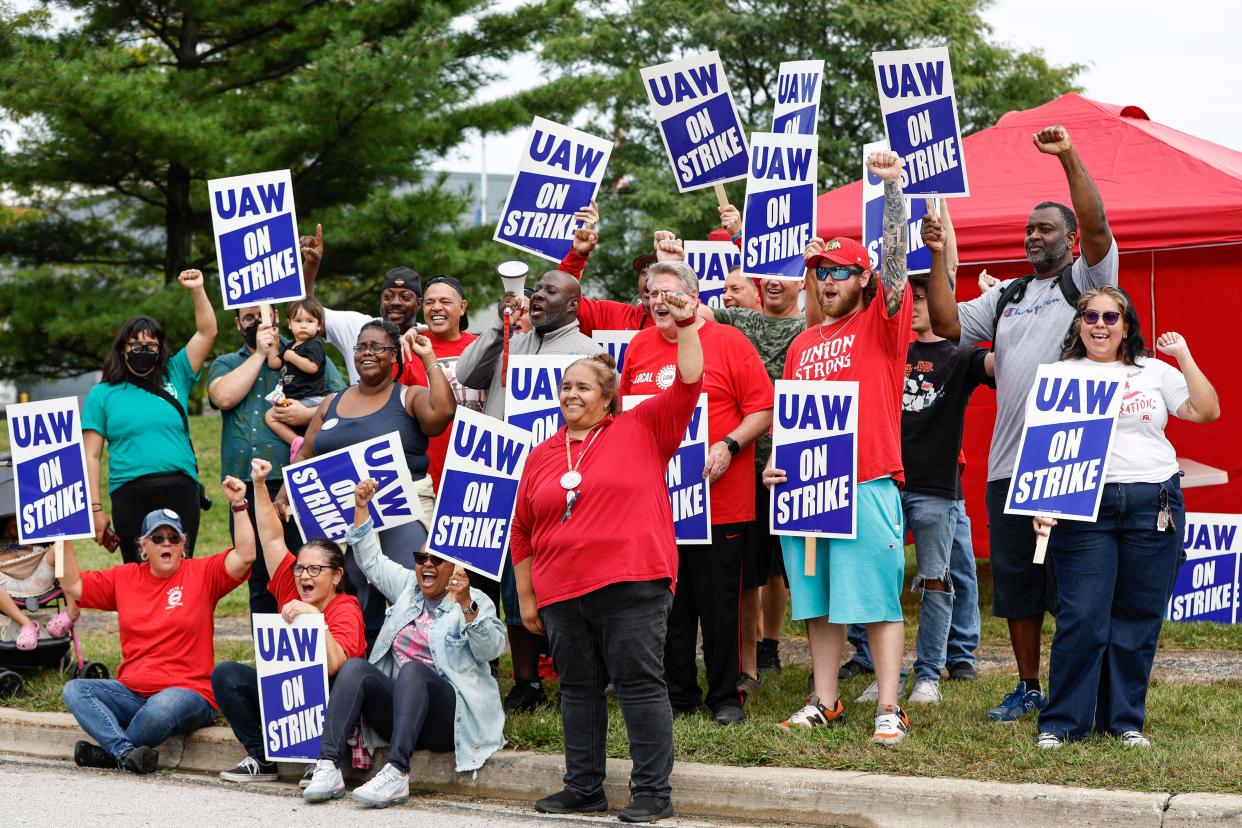Joe Biden joined the picket line, but did Donald Trump help create the UAW strike?

- Oops!Something went wrong.Please try again later.
- Oops!Something went wrong.Please try again later.
On Friday, Sept. 22, what began as a targeted stand-up strike by 13,000 UAW workers at three plants owned by Ford, GM and Stellantis was expanded to an additional 38 locations for GM and Stellantis. On Tuesday, President Biden joined the UAW picket line in Michigan, something no president has done before. I believe this is not an appropriate action for a U.S. president. One should be tempted to believe that Biden has done more to help the UAW strike than any other president — but you would be wrong.
Part of the reason the UAW is in a strong position to strike is because of the replacement of the North American Free Trade Agreement (NAFTA) with the U.S. Mexico Canada Association (USMCA, in 2019/2020). The USMCA created greater business restrictions in the auto industry in three ways. First USMCA requires 75% of vehicles parts be made in North American (up from 45% in NAFTA A and up from 62.5% under later NAFTA requirements). Second, auto manufacturing and parts manufacturing must be performed by workers earning at least $16/hour. And third, North American car and truck manufacturers will also have to purchase 70% of their steel and aluminum in US, Mexico or Canada in order to avoid tariffs.
Every action or policy change has winners and losers. There are three categories of losers for the greater restrictions on the auto industry implemented under USMCA. First, there are the small Mexican auto manufacturers and auto parts manufacturers who can’t afford to pay $16/hour; some will, in the long run, go out of business or cease to export to the U.S. or Canada. The second group of losers are the employees who would have had a job, albeit at lower wages, who are now without that job in the auto industry, the auto parts industry, or other support industries in Mexico and the U.S. In the long run, this includes U.S. UAW workers (or potential employees who would have been UAW members) as manufacturers substitute away from union labor to greater levels of automation. Job losses also occur as more plant closures occur (as many as 17 plants by Stellantis alone if UAW demands must be met). Addition job “losses” occur since each year U.S. auto sales will be less than they otherwise would have been. One estimate was 1.3 million fewer vehicles per year due to higher auto prices — before the strike. Obviously, post-strike numbers will be even greater.
The third group of losers are consumers who pay higher prices for vehicles, as much as $2,200 per vehicle — before the effects of the strike.
The obvious winners are those who actually keep a job in the auto industry at higher wages both in the U.S. and in Mexico.
To many readers this description of USMCA may come as a surprise. President Trump touted the deal as good for trade and a win for — well — everybody. The final was clearly pro-union, endorsed by Nancy Pelosi and the president of the International Brotherhood of Teamsters, who said USMCA produced “considerable progress on workers’ rights.” Richard Trumka, president of the AFL-CIO, claimed that union leaders greatly “improved” USMCA in later iterations.
The free enterprise and free trade-oriented Cato Institute stated: “Regulation is a general problem in the USMCA, even more than it was in NAFTA.”
Would Donald Trump really have left us with a trade deal worse than NAFTA and with so many business restrictions? The short answer is — yes. Unlike most prior Republican leaders who favored free trade, Donald Trump is essentially a protectionist. This is the same man that said import tariffs are “beautiful.” His increased import tariffs (especially on Chinese goods and components imported by U.S. businesses) increased costs to American consumers by between $17 billion and $48 billion annually.
Let me identify one more winner from USCMA and the strike — Tesla. Business Insider states: “Ford and GM already spend $20 more an hour on factory workers than Tesla. The UAW's demands would more than double that gap.” The higher costs for the Big 3 and the higher resulting prices for Big 3 vehicles are great news for Tesla.
USMCA and higher import tariffs would not have come into existence without Donald Trump. His pro-union protectionist policy greatly strengthened the UAW and its ability to strike and/or negotiate higher UAW wages. This leads to higher prices for consumers. The higher prices caused by “protecting” some American jobs, while losing others behind the scenes is simply bad policy.
Steve G. Parsons, Ph.D,. is a retired consulting economist with former clients around the world. He was also an adjunct professor for more than 20 years at Washington University in St. Louis, where he taught the economics of technology to graduate students in the school of engineering.
This article originally appeared on Springfield News-Leader: Did Donald Trump help create the UAW strike?

